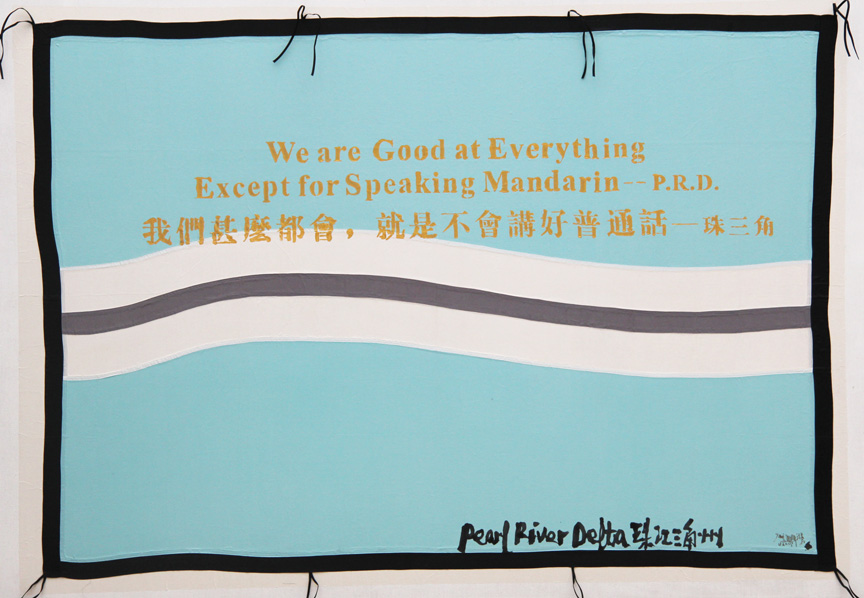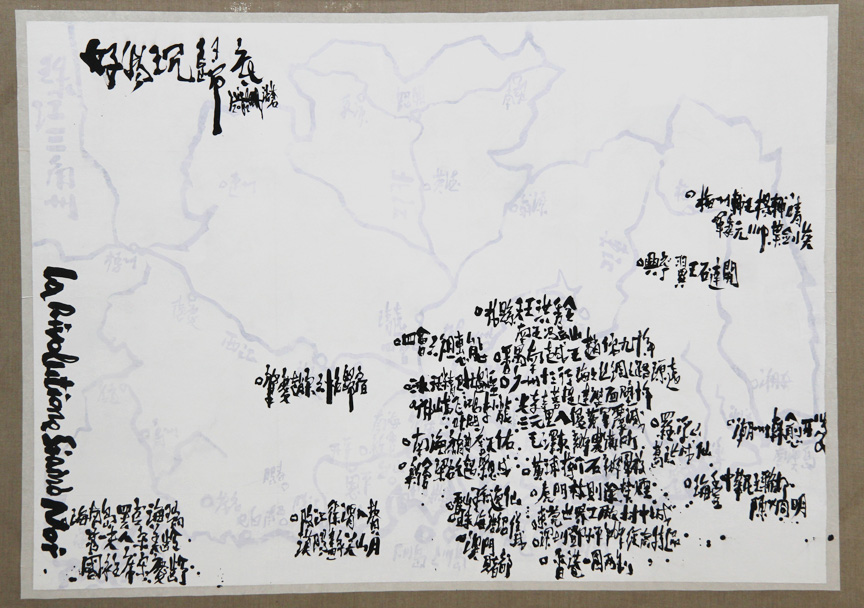Yang Jiechang’s “King of Canton”
By Miryam Rodriguez

YANG JIECHANG, We Are Good at Everything, Except for Speaking Mandarin – PRD, 2005, acrylic on silk mounted on canvas, 162 × 229cm. Courtesy Hanart TZ Gallery, Hong Kong.
Although southern China’s Guangdong province has been the birth place of emperors and Chan Buddhist patriarchs, it has never had its own king. Now is the time for Hong Kong’s Hanart TZ Gallery to fill in this gap, claims Guangdong-born artist, Yang Jiechang, in the exhibition catalog to his current solo show. The gallery is doing precisely that, dutifully carrying out Yang’s decree in their one-room gallery space on Pedder Street with the exhibition “King of Canton,” composed of six works, including new pieces created this year. In a variety of media and techniques, including traditional ink painting, black sandalwood, a video installation and neon light, Yang aesthetically reflects on his home province’s history and physical attributes, claiming it is so “blessed” it can stand alone, as its own country.
Yang, born in the city of Foshan, in the north of the Pearl River Delta (PRD), studied at the Guangzhou Academy of Fine Arts in the provincial capital. He left for Paris in 1989, to take part in the seminal “Magiciens de la Terre” exhibition, and stayed, living for the last 20 years between Paris, and Heidelberg, in Germany. Although part of the diasporic Chinese community, Yang continues to hold an affinity for the region he describes as “good at everything except speaking Mandarin.” The Putonghua exception is not an imperfection Yang seeks to correct. Rather, he places emphasis on the vitality of Guangdong’s Cantonese culture in his works.

YANG JIECHANG, Self-portrait – King of Canton, 2012, stuff toy animal, wooden mask, fabric and pedestal with plexiglass cover, 140 × 45 × 38 cm. Courtesy Hanart TZ Gallery, Hong Kong.
At Hanart TZ, one is immediately greeted with the 27-minute video King of Canton – Jalada Jolidi (2012), installed on the wall opposite the entrance. The video shows five identical plush animals, dressed in regal outfits bopping in place. Across from this is a similarly dressed stuffed toy, Self-portrait – King of Canton (2012), in which Yang portrays himself as a rodent wearing a stoney human mask, regal crown, cape and wooden sword; a potential king, masked but present. Adjacent to the video installation of the playful Cantonese candidates, hang two monochromatic ink paintings, opposite another acrylic on silk work bearing what seemingly has become the slogan of the campaign to find a Cantonese king, We Are Good at Everything, Except for Speaking Mandarin-PRD (2005). These three works, each mounted on canvas, seem fragile in the presence of the sculptural piece The Most Beautiful Country of China (2009), a Cantonese pagoda façade, crowned with neon lights bearing the work’s titular assertion. Together, these works textually and symbolically support Yang’s claim that, while many have relied on Guangdong’s acumen and talents historically, the nation's founding story or memory fails to recognize this.

YANG JIECHANG, La Rivoluzione Siamo Noi, 2012, ink and acrylic on rice paper mounted on canvas, 162 × 224 cm. Courtesy Hanart TZ Gallery, Hong Kong.
On one of the two ink paintings mentioned above, titled La Rivoluzione Siamo Noi (“We Are The Revolution,” 2012), Yang depicts the cultural productivity of Guangdong’s PRD region. On delicate rice paper, showing a subtly drawn map of the region, Yang writes the names of prominent figures from modern and ancient Chinese history, including revolutionaries, such as Sun Yat-sen, who also hailed from Guangdong. Borrowing the message of Joseph Beuys’ 1972 work of the same title, Yang expresses the idea of art’s transformative power and the role of the artist as an individual capable of bringing about real world change through art. The work thus presents an alternative perspective to the one that Chinese culture emerged from the country’s Mandarin speaking north.
Yang often employs Chinese ink and calligraphy painting—which, after studying as a child, played a large role during his formal art training as a student in Guangzhou—to promote his subversive messages, but his style is also influenced by his encounters with European artists and ideas. In 2007, Yang went to Finland and visited the former studio of late 19th-, early 20th-century Finnish artist, Akseli Gallen-Kallela. During this visit Yang was inspired by Gallen-Kallela’s national Finnish style and portrayals of his local landscapes, as well as by the artist’s struggle with what he saw as the “Russianization” of Finland at the time. Similarly, Yang fears the “Mandarinization” of southern China, which may destroy the linguistic and cultural diversity Yang believes enriches the region, and China in turn.
Hong Kong may be a viable platform to introduce the world to “The King of Canton," with its Cantonese heritage and strong sense of local identity. After all, Hong Kong was historically part of Guangdong province before it became a British colony in 1842. At Hanart TZ, Yang has created a temporary Cantonese throne, though it may be usurped come late June, when the exhibition closes.







